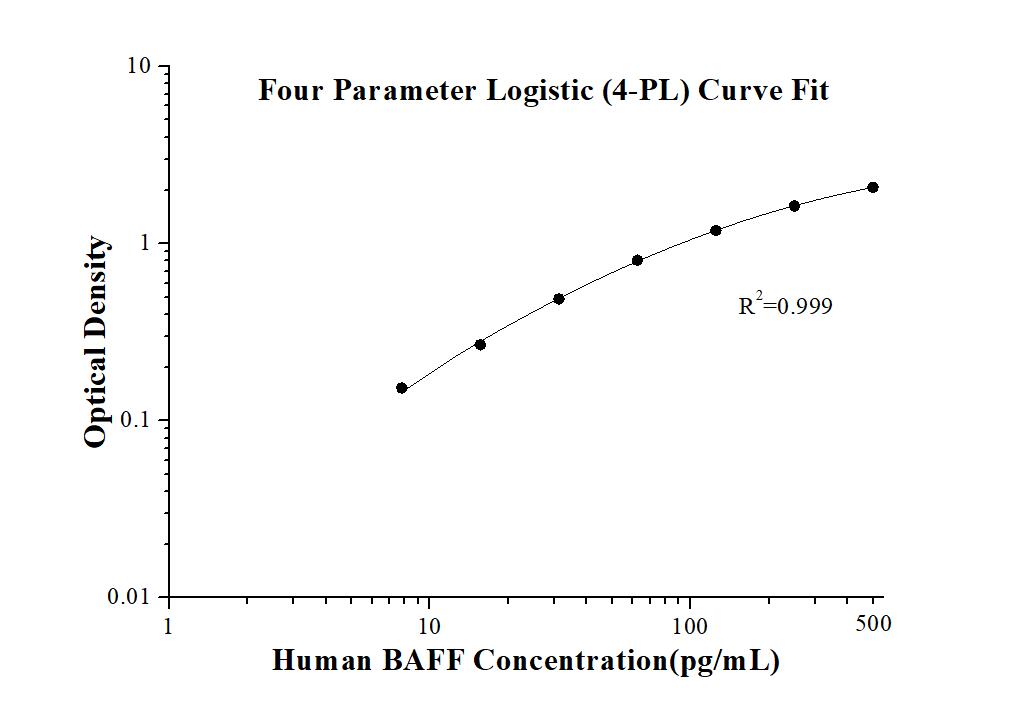Human BAFF ELISA Kit
Sensitivity
0.5 pg/mL
Range
7.8-500 pg/mL
Reactivity
Human
Cat no : KE00215
Synonyms
B cell activating factor, B lymphocyte stimulator, BAFF, BLYS, CD257, DTL, TALL 1, TALL1, THANK, TNFSF13B, TNFSF20, ZTNF4
Validation Data Gallery
Product Information
KE00215 is a solid phase sandwich Enzyme Linked-Immuno-Sorbent Assay (Sandwich ELISA). The BAFF ELISA kit is to be used to detect and quantify protein levels of endogenous BAFF. The assay recognizes human BAFF. An antibody specific for BAFF has been pre-coated onto the microwells. The BAFF protein in samples is captured by the coated antibody after incubation. Following extensive washing, another antibody of biotinylated specific for human BAFF is added to detect the captured human BAFF protein. For signal development, Streptavidin-HRP is added, followed by Tetramethyl-benzidine (TMB) reagent. Solution containing sulfuric acid is used to stop color development and the color intensity which is proportional to the quantity of bound protein is measurable at 450 nm with the correction wavelength set at 630 nm.
| Product name | Human BAFF ELISA Kit |
| Tests | 1 X 96 well plate |
| Sample type | Serum, Plasma, Cell Culture supernatants |
| Assay type | Sandwich |
| Sensitivity | 0.5 pg/mL |
| Range | 7.8-500 pg/mL |
| Reactivity | Human |
| Tested applications | Sandwich ELISA |
| Gene ID (NCBI) | 10673 |
Recovery
| Sample Type | Average | Range |
|---|---|---|
| Human serum | 98% | 72%-125% |
| Cell Culture supernatants | 102% | 75%-128% |
IntraAssay
| Sample | n | mean ( pg/mL) | SD | CV% |
|---|---|---|---|---|
| 1 | 20 | 196.3 | 8.3 | 4.2 |
| 2 | 20 | 46.8 | 2.0 | 4.2 |
| 3 | 20 | 11.3 | 0.6 | 4.9 |
InterAssay
| Sample | n | mean ( pg/mL) | SD | CV% |
|---|---|---|---|---|
| 1 | 24 | 182.2 | 14.5 | 8.0 |
| 2 | 24 | 42.6 | 1.6 | 3.7 |
| 3 | 24 | 9.4 | 0.3 | 3.7 |
Background Information
BAFF, or B cell-activating factor, also known as B lymphocyte stimulator (BlyS; trademark of Human Genome Sciences, Rockville, MD), TALL‐1, THANK, and TNFSF13B, is a member of the tumor necrosis factor (TNF) superfamily and is best known for its role in the survival and maturation of B cells. The full-length molecule of BAFF is a 285-amino acid (285 aa) peptide with 2 potential N-glycosylation sites at residues 124 and 242. Cleavage downstream from aa 124 releases a first form of nonglycosylated BAFF, and possibly a second form glycosylated at aa 242. A 152-amino acid form can also be shed from the membrane and is detectable in human serum. Studies on BAFF transgenic mice and patients with rheumatoid diseases indicate that overexpression of BAFF is linked to the development of autoimmune pathology. BAFF expression was detectable in heart, skeletal muscle, pancreas, kidney, skin with adipose tissue, and liver at similar levels as in the CNS.
Properties
| Storage Instructions | All the reagents are stored at 2-8℃ for 6 months or -20℃ for 12 months. Refer to the protocol for further storage instructions. |
| Synonyms | B cell activating factor, B lymphocyte stimulator, BAFF, BLYS, CD257, DTL, TALL 1, TALL1, THANK, TNFSF13B, TNFSF20, ZTNF4 |

